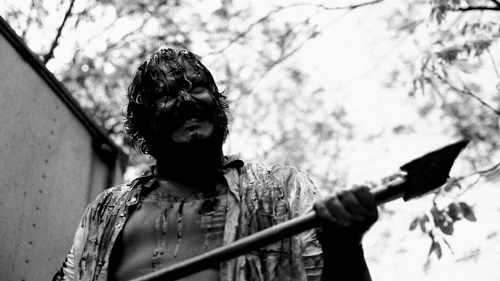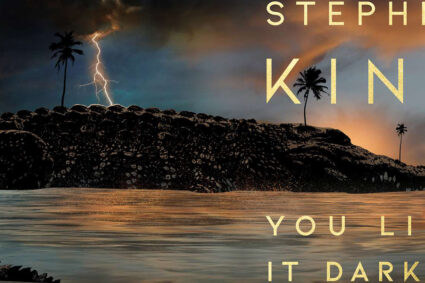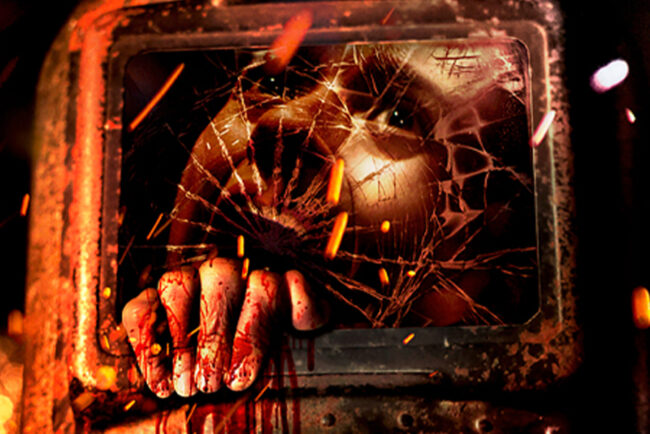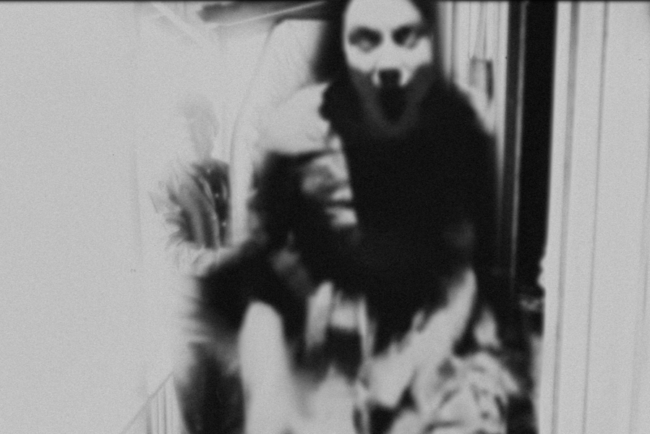
When most people hear “Wisconsin” there are a few things that come immediately to mind. The Great Lakes state located in the Unites States’ Midwest region is composed of green rolling hills, farms, and forests. It boasts the world’s most primo cheeses, an absurd number of beers (and beer-drinkers), and of course the Green Bay Packers. To many Ravenous Monster Readers though, it’s a safe bet that the names Ed Gein and Jeffrey Dahmer are synonymous with the dairy state’s dank and deranged underbelly.
But what most of you probably don’t know is that Wisconsin has a burgeoning collective of filmmakers who over the past handful of years have made some of the most bizarre, repugnant, and just plain weird horror and exploitation flicks in the world. And soon it will be impossible for horror fans to remain ignorant about this bubbling cauldron of crazy even if they want to because, HOLE IN THE WALL—a gonzo anthology flick made by some of these camera-toting cretins, will finally hit the festival circuit before spreading across the globe like a rancid plague.
The list of filmmakers who’ve contributed segments to HOLE IN THE WALL include the duo behind Slasher Studios Steve Goltz and Kevin Summerfield, Screaming like Banshees team Rob Michels and Carolyn Baker, as well as the mad scientist behind the INCEST DEATH SQUAD films, Cory Udler, IDS star and frequent Udler collaborator, Greg Johnson, and one of the sickos that belched forth SWAMPHEAD into the universe, Derrick Carey. While the output of these filmmakers is various, from stomach-turning hilarity to mind-rending exploitation trash and everything in between, the filmmakers themselves are united by a voracious compulsion to subvert the dominant paradigm. They don’t just push the boundaries with their movies, they head-butt the boundaries in the face and kick them down the cellar stairs.
Ravenous Monster caught up with HOLE IN THE WALL producer and co-director, Derrick Carey to find out more about this twisted revulsion of a movie and a whole lot more. Watch the HOLE IN THE WALL trailer below and then read on, Horror Fans….
RavMon: It’s been a while since you’ve donned the proverbial director’s hat. How did it feel to get back behind the camera for the wraparound segment of Hole in the Wall?
Derrick Carey: Felt great! As an editor, I find the switch to directing to not be a stretch. I know what I want and what I don’t cause I can see how things will flow together visually and continuity wise. I already have seen and edited the film in my head so it comes easy on set, baring unforeseen obstacles (which inevitably always happen). Actually, I get stressed out about scheduling more than directing.
Ultra low budget shoots like “The Plainfield Chopper” and “Legend of the Ax” force the creator to wear many, many hats. So along with writing and directing the piece, I am also the editor, score composer (to and extent) and producer. It can all become rather overwhelming, but if you want to actually get a movie made, you have to just throw fears to the wind and go for it. Luckily for me, I know some absolutely amazing people that have stuck with me over the long development and production cycle that Hole in the Wall has gone through to help make this film.
RavMon: How did Hole in the Wall come to be?
DC: Hole in the Wall started life as an excuse for Cory J Udler (Incest Death Squad series) and I to work together. We had met each other at John Pata’s (Dead Weight) annual Oshkosh Horror Film Festival and hit it off right away. I love the bite his films have satirically and exploitation wise. Our tastes are very closely aligned. Also, he’s a doer and not a talker, which there are far too many of in this business. The man has cranked out 5 films in just as many years and I love them all. That is astounding to me!
Both of us have insanely crazy schedules, so we figured the best way to test the waters of collaboration would be an anthology film. It allows us to collaborate on an overall theme and concept, yet only need to worry about small, manageable films on modest budgets.

Something we loved about the Oshkosh Horror Film Festival was that everyone involved was extremely passionate about their work and the energy amongst the filmmakers was inspiring. It’s a film fest for fans and filmmakers. We all go to enjoy a day watching weird, fucked up horror. It’s a great time. The camaraderie is great and you inevitably meet people that you become friends with and potentially work with.
Hole in the Wall is the direct result of our love for the people we have met in the Wisconsin horror film scene. The people we have enlisted for this film are the amazing Rob Michels and Carolyn Baker/Screaming like Banshees, the Slasher Studio Boys behind last year’s Don’t Go to the Reunion, Steve Goltz and Kevin Summerfield, and longtime contributor and actor of Cory’s, Greg Johnson. The first credit you see in the film reads “the Wisconsin Horror Mob presents” because we feel like a collective; a mob of strange goons, working together to create “fun” subversive work.
RavMon: It seems like anthologies have been making a comeback lately (V/H/S, The Theatre Bizarre, Sanitarium, Chillerama). That’s a good thing. How will Hole in the Wall stack up to or stand out among some of these other recent anthologies?

DC: How will it stick out? It is the product of a specific geographic region. This is us saying, for better or worse, Wisconsin has a horror film scene and here are some of the voices involved. There were many more people we wanted involved, such as my long time collaborator Jason Paul Collum (October Moon), Nick Sommer/Drew Rosas (Blood Junkie), and Bradley Sullivan (I Didn’t Come Here to Die), but everyone is constantly making new things. We didn’t want to interrupt the great features that everyone is currently making which will be dropping soon. Maybe we can get them in next time.
The only rules we laid out for our filmmakers were to let loose and push the boundaries. No holds barred. The films can be funny, crass, gross, disturbing, sexual, dramatic, etc. The Sky is the limit. The emphasis is to have fun and make something you’d want to see as a horror fan. We are ultra low budget independent filmmakers. We have the freedom to make whatever content we wish that our budgets would allow. We don’t care if it goes too far because we don’t have people to answer to. That’s the fun at the heart of a project like this. We wouldn’t call our film Hole in the Wall if we were concerned with offending people. You’ve seen our poster right?
RavMon: I have seen it. And if the movie is the logical extrapolation of the poster…well, it’ll be interesting to say the least. I was looking at some of your Hole in the Wall/Plainfield Chopper production photos. Were you shooting with a Canon 7D? What other gear did you employ this time out?
DC: You are correct. We shot with 2 cameras actually. A Canon 7D and a Canon T2i. It was mostly to maximize coverage and shorten the production schedule. Stacked up next to each other, the 2 cameras are pretty comparable when all is said and done. The footage looks very similar when it is sitting before you. With a good eye and decent glass (lenses), you can make those cameras’ sing.
Originally we considered, because we had it at our disposal through a good friend of ours, shooting Chopper on a RED EPIC. We, DP Justin Propp (Swamphead) and I, decided that we wanted this to be quick and dirty. There is no reason to shoot something like The Plainfield Chopper in 4K. The looks of the shorts in Hole in the Wall will be all over the place because we wanted people to shoot on what they were comfortable with and what forced them to be the most creative. Does that mean it will look like shit? Absolutely not, but it will reflect the voices of the individual filmmakers. It’s my job in post to match them enough so that the experience isn’t too jarring, but because some where shot in SD, there’s only so much you can do.

RavMon: Is the price-to-quality ratio of shooting with a DSLR a game changer when it comes to what those of us who have been on the outside looking in can accomplish?
DC: Absolutely! That ratio is even more so with some of the new cameras coming out like the Black Magic Camera, and some of Sony’s new cameras. With the new round of smaller cameras at reasonable price points ($3k for a camera that can shoot 4K? Holy crap!), it opens the floodgates and gives opportunities for aspiring filmmakers to tell their stories and not just stand by twittling their thumbs. While I am a tremendously huge fan of SOV films, let’s face it; most people don’t like watching films that look like their grandma could have shot them. They just aren’t marketable on a wide scale, and that’s a fact.
While some see the democratization of gear as the watering down of the market with amateur filmmakers and subpar product, I see it as an opportunity for some wildly different voices to change the status quo of the genre. Hollywood and mass market Horror is a stagnant moat of boring remakes and safe retreads. Even if I have to wade through 100 shit films to find that 1 film that is something new and subversive, I feel it is worth it.
Ravmon: As a judge of the last Madison Horror Film Fest, I had the pleasure of seeing a couple films that you were involved with in varying capacities – Swamphead, which is hysterical, and Dead Weight, which is bleak and tense. It seems proof positive that the Wisconsin horror and exploitation scene is an actual ‘thing’, no?
DC: Glad you liked them!!!
To even mildly say that there is “kind of a scene” is understating the fact that there is an explosion of horror films coming out of this state. All you have to do is come to the Oshkosh Horror Film Festival to see that the number of horror filmmakers is growing year by year.

There are some utterly great, passionate people making fun, subversive films here right now. If I were truly a fan of Horror films from outside the state, and not a fair weather fan of corporate fads, I would keep my eye out for the people making films here. They aren’t just films being made for their friends to watch. They are films receiving national distribution such as I Didn’t Come Here to Die, Blood Junkie, Screaming in High Heels: The Rise and Fall of the Scream Queen Era, A Cadaver Christmas, and Dead Weight. These are all just within the last couple of years!!!
RavMon: What were the stories and who were the storytellers that inspired the young Derrick Carey down the perilous path to becoming a storyteller in your own right?
DC: From a young age my parents via Stephen King and Universal Horror introduced me into horror. When I was old enough to read longer form fiction, my mom let me check out books like Night Shift. I used to carry around my copy of that book and Danse Macabre, King’s book on horror media, and reread them over and over again. Horror in short form has the ability to carry a ridiculously powerful punch. Which leads me to why Hole in the Wall was such an interesting project to me.
RavMon: What is it about horror films and exploitation films that appeals to you as both a fan and a filmmaker, assuming there’s a difference?
DC: The sense of danger. The adrenaline rush of a good horror movie is tough to beat. I am also an immense fan of films that love to subvert the status quo, as I think most people are lulled into a state of complacency by mass market media. Exploitation and horror aren’t afraid to push boundaries and talk about, and present subjects that need to be talked about, albeit in a fantastical or sensationalist way. Much like speculative Science Fiction, good horror/exploitation can have a lot to say. They don’t always need to, as entertainment should be at the top of every film’s list, but when they do they pack a punch like nothing else out there. These types of films also allow certain urges to be satisfied in a way you couldn’t satisfy elsewhere. I don’t think anyone should ever be ashamed of enjoying violent, sexual, or strange cinema. We see it everyday on the news through the guise of corporate/religious America. Don’t ever let people tell you that your existence is a detriment to our society, be more afraid of not questioning and not exploring what makes you afraid.

RavMon: Which current filmmakers or films really blow your mind?
DC: For the most part, I follow and get excited for underground, independent filmmakers. The passion and energy is what draws me to them.
If I was to name a few that I follow and get excited for I would first have say my good friend Andrew Shearer is a huge inspiration to me as a filmmaker. If you haven’t seen is work under Gonzoriffic Films, you need to do so immediately. He’s someone working outside of the system that absolutely doesn’t care about fitting in, and that appeals to me immensely because the most subversive and interesting kind of work develops when people come from that angle. Some other people would have to be JT Petty, Astron 6, Dustin Wayde Mills, Adam Ahlbrandt, Edwardo Sanchez, and the boys who made The Taint.
To me, The Taint is one of the most singular and original exploitation films made in the last 15 years easily. It destroys all the rules and comes out the other end with a crazy; fucked up, mind blowing experience on a tiny budget that can’t be beat. Its energy is atom bomb level. I am feverously looking forward to their new film Science Team.
RavMon: You’ve been involved with some really interesting documentaries, including editing the horror docs Screaming in High Heels: The Rise and Fall of the Scream Queen Era and Sleepless Nights: Revisiting the Slumber Party Massacres, and you worked on sound for the money-in-politics doc As Goes Janesville. What is it about the documentary form that you find appealing? Are there any areas where documentary filmmaking and fictional filmmaking overlap?

DC: Real life will always be a more interesting and unpredictable story than anything anyone could ever come up with. While the documentaries I have been a part of with Jason Paul Collum aren’t the kind of films that As Goes Janesville is, it was great to sit and be around and tell the stories of these people that made the films that shaped our cinematic tastes at very young ages.
The people involved with Screaming in High Heels are actors and directors that largely get overlooked and frowned upon by not only mainstream audiences, but by genre folk alike. However, there are a ton of us out there that grew up going to the video stores, renting films such as Night of the Demons, Silent Night Deadly Night, Sorority Babes in the Slimeball Bowl o Rama, and Slumber Party Massacre. So we wanted to honor them, and give them the spotlight they deserved for everyone to recognize that they were culturally important to many people.
Every film, be it narrative fiction to documentaries is false by design. They are edited, and in turn made to be a reflection of the ideals and feelings of the filmmakers. You may go in intending to make something with an objective viewpoint on a subject, but you always err on the side of making sure you are engaging an audience, and telling a resonant story.
If you wanted to watch a truly objective film, watch a surveillance camera feed. Ha ha.
RavMon: What’s it like editing a film that someone else directed like Swamphead? How do you approach it?
DC: Editing, whether it is your work or the work of others, is a highly creative and collaborative art. I’ve been lucky enough to work on projects where the directors are very trusting of me to make the right decisions on what works for the film/project as a whole.
If it’s not my project, and I am a hired gun to come in and edit a film, I always want to have the director’s vision in mind. However, I am never married to a script or to the footage I have before me. Most low budget films don’t have the luxury of reshooting things after principle photography has wrapped, so they have to work with what they have. Sometimes that means making hard decisions and rethinking the film as a whole. If I have to give advice to aspiring editors/filmmakers it would be to NEVER be afraid to cut things out of a film. If it doesn’t work, slows the film down, and/or takes the viewer out of the experience, get rid of it. On the level we are on, you can’t afford to be pompous and think everyone wants to watch your 3 hour epic SOV film. I’ll take a tight 70 minute indie exploitation film over a 2 hour one any day of the week.

Too many distributors force films to be 90-plus minutes when they don’t need to be. The standard needs to change. Not every film needs to be Lord of the Rings. ESPECIALLY in the age we live in of YouTube, vine, and twitter. Short, to the point films should be a goal to strive towards for filmmakers working with very limited budgets. Shit, I think most Hollywood films would benefit by being 60-70 minutes films.
In the case of Swamphead, it was a film that was teetering on the edge of dying when I came aboard. The directors had split due to stress, as the film had been in production for 3 years on and off, and I had been little by little becoming more of a presence trying to help them finish it. Eventually I asked Justin Propp if he had a film in the footage he had shot, as they hadn’t filmed the whole script yet. He thought there might be, so I told him to give us the chance to cut a film with what he had and see if we could make it work. It took us a while, but we realized that the film was there and the scenes that weren’t shot didn’t need to be. It was perfect the way it was. If we hadn’t started the process of cutting it, Swamphead would have died like many other low budget films do. I loved the film so much that I did anything I could to make sure it wouldn’t. Dustin and Justin made one hell of a fun film.
Swamphead was a very collaborative post-production. As Justin and I cut, we then screened the cuts and went out to shoot new sequences based on viewers reactions and notes. Justin and I got hold of every creative person we knew that would get the film and want to be involved with making it the best it could be. It was a very drawn out, and in the end, exhausting experience that I hope to not replicate on any film I make from now on. In total, I think from birth to release (available through Wild Eye), it will have been an almost 7 year film. It’s the perfect example of what could go right and wrong on no budget indie features.
RavMon: In the pantheon of cinematic glory, which movie do you wish you’d directed?
DC: Martin. George Romero’s Martin is my idea of a perfect genre film. It’s quirky, heady, surreal, subversive, horrific, and tight. For my money, it’s the best vampire film ever made. While Texas Chainsaw Massacre (1974) is my favorite horror film, I think Martin is something more along the lines of what I am interested in making.
RavMon: What are the post-postproduction plans for Hole on the Wall?
DC: We plan on road showing the film for a while at festivals and conventions. Cory and I wanted to have this be a midnight-style/drive-in experience. It’s around 80 minutes long, perfect for an audience of folks coming in from the bars at midnight, looking for something wild. If we get the right kind of distributor to come at us with a deal that suits not only everyone involved but the film itself, then we will release it through them. If not, we will do it ourselves through the avenues that the Internet gives each of us. This film is DIY all the way and a group venture. I would love it to be something passed by word of mouth and handed from fan to fan. It was a film made by fans for fans.
RavMon: Looking beyond Hole in the Wall, what’s next for you?
DC: Hopefully sometime in the near future we will finally release Jason Paul Collum’s Safe Inside, a monster in the house thriller that we all shot a couple summers ago. Cory and I are currently writing a heavy metal horror film. I have a bunch of scripts just waiting to be shot. There are also rumblings of other WI horror films that I may help with, including more documentaries. So who knows what will pop up? All I know is that the train isn’t stopping anytime soon.















